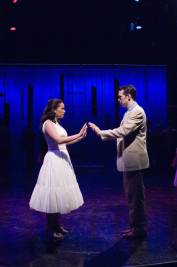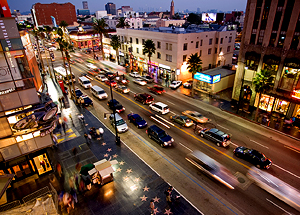
If ever a Broadway musical deserved to be called a classic, that musical is West Side Story. What must Broadway audiences have felt as they first discovered it back in 1957? This was, after all, a Broadway whose most recent Tony-winners were My Fair Lady, Damn Yankees, and The Pajama Game. What must audiences who were accustomed to this sunny fare have thought about a show whose leading man and leading lady didn’t have the proverbial happy ending, and whose characters lived dismal lives in the worst parts of Manhattan and hated anyone whose differences threatened their go-nowhere existences? What must they have thought about Leonard Bernstein’s jazzy, operatic score, about Stephen Sondheim’s poetic lyrics, about Arthur Laurents’ Romeo and Juliet inspired book, and above all about Jerome Robbins’ truly revolutionary choreography? How must West Side Story have rocked the world of those Eisenhower-era 1950s New Yorkers and, even more so, of the out-of-towners who make up so much of a Broadway show’s audience?
This updated Romeo And Juliet set on the mean streets of New York City may seem tame compared to the gang warfare flashed on today’s TV screens, but its tragic tale of star-crossed lovers remains as powerful as ever, and one that is played out daily whether by rival gangs in America’s inner cities or by Israelis and Palestinians in the Middle East or by Catholics and Protestants in Northern Ireland. Only someone with a heart of stone could fail to be moved by the love which ignites between born-in-the-USA Tony and recent Puerto Rican arrival Maria one fateful night at a high school gymnasium—only to be extinguished just a day later on the West Side streets of Manhattan.
The program for the PCPA production of West Side Story now playing in Solvang reads “Entire Original Production Directed & Choreographed by Jerome Robbins,” and many revivals, even the current Broadway incarnation, have Robbins’ iconic choreography “reproduced” by their choreographer. It takes chutzpah and talent in abundance for a director-choreographer to decide to put his or her own stamp on West Side Story—and have it work. Michael Jenkinson is both gutsy and gifted, and his subtly tweaked production of the Robbins- Bernstein-Sondheim-Laurents trailblazer is about as sensational as it gets.
Jenkinson has clearly been inspired by Robbins’ original dance moves, but those on stage at the Solvang Festival Theater are different enough from Robbins’ to make an audience sit up, take notice, and cheer. One obvious revision is the addition of a trio of Jet girls to “Cool,” the mix adding extra spice to that number and at least one other.
Then there’s Jenkinson’s decision to flip-flop “Cool” with “Gee, Officer Krupke,” moving the latter from its position mid-Act Two to “Cool”’s usual Act One spot, and vice versa. West Side Story’s original team clearly felt the need of a mid-‘50s audience for (comic) relief from West Side Story’s steadily darkening second act. Contemporary audiences are more willing to take their darkness black, and by placing “Cool” between the “Somewhere” dream ballet and Anita and Maria’s “A Boy Like That,” Jenkinson keeps the dramatic tension high as events (and one horrible lie) lead to West Side Story’s inexorable, tragic conclusion.
All the excitement of West Side Story’s ground-breaking “Prologue” is there in Jenkinson’s respectful reinterpretation of Robbins’ balletic leaps and bounds and the same is true with the Act One closer, “The Rumble.” The “Somewhere” ballet’s dream of a world without gang rivalry and hatred has never been more clearly stated, or more moving, than it is here, as choreographed by Jenkinson and costumed, entirely in white, by Jim Tanner.
The current Broadway revival originally substituted Spanish lyrics for English ones in “I Feel Pretty” and “A Boy Like That.” This was one case where meddling meant middling, a mistake which was rectified when Sondheim’s originals were reinstated some time after its opening. PCPA wisely sticks with Sondheim, mostly, but even the substitution of “tan hermosa” for “oh so pretty” in “I feel pretty, oh so pretty, I feel pretty and witty and bright,” spoils the effect of Sondheim’s deliberate alliteration, and the same is true for inserting “encantadora” in the place of “oh so charming” in “I feel charming, oh so charming, it’s alarming how charming I feel” which messes with the “charming-alarming” rhyme—and Stephen Sondheim is one lyricist you don’t want to mess with.
Still, when quibbles as minor as these are the only ones a reviewer can come up with, it’s obvious that the production’s director-choreographer and cast know exactly what they are doing—phenomenally well.
Following his starring roles in Camelot and Jacques Brel …, West Side Story makes it three big shows in a row for Zachary Ford, a dynamic Tony who not only sings the part in his distinctive tenor but puts authentic acting chops into it as well. George Walker and Kevin Kiler both do excellent work as rival gang leaders Bernardo and Riff. A sensational Rhett Guter (Diesel) gets to sing and dance the lead in “Cool,” a song usually performed by Riff, but as West Side Story fans know, Riff doesn’t make it to Act Two. The charismatic Kiler is joined by the terrific Jet dancers (Guter, Steven Stone as Action, Daniel J. Self as Baby John, John Keating as A-rab, Justin Crabtree as Snowboy, and Aaron Lopez as Big Deal) for the thrilling “Jet Song,” and the multitalented Jet boys get laughs galore in the show-stopping “Gee, Officer Krupke.”
The Sharks aren’t given quite as much stage time as the Jets (with the exception of Bernardo and Chino, the latter given a fine performance by Brian Conway), but they are equally “fantasticos” as singer/dancer/actors: Glenn M. Snellgrose II as Pepe, Keenon Hooks as Juano, Steven Jasso as Indio, TJ Mundy-Prunchard as Luis, and Nikko Kimzin as Anxious.
The triple-threat ladies make strong impressions as well, especially with the extra stage time they are given in Jenkinson’s West Side Story. They are Emily Susanne Franklin (Graziella), Jillian Van Niel (Velma), Jillian Van Niel (Velma), Angela Nicholson (Minnie), Louise Tremblay (Clarice), Deanna Ott (Della), Laura Pronge (Pauline), Layli Kayhani (Consuela), Sheena Motlo (Margarita), Leah Hart Kolb (Francisca), Marisa Martinez (Estela), and Kaitlyn Casanova (Rosalia).
In other roles, Billy Breed is a powerful Doc, and Evans Eden Jarnefeldt (Lt. Shrank), Casey Kooyman (Officer Krupke), Natasha Harris (Anybodys), and Jonathan Grunert (Gland Hand) do top-notch work as well.
Finally, there are West Side Story’s two leading ladies, Mindy Lym as Maria and Sarah Girard as Anita, a pair of gifted performers who pretty much steal the show whenever they’re on stage, and never more so than in an impassioned “A Boy Like That.” Put a short black wig and slinky dress on Girard and she’s transformed into a stunning sexy spitfire of an Anita. As for Lym, we Angelinos can only hope that this Bay Area treasure will grace us with her presence in the not so distant future. It’s almost worth the price of gas just to see (and fall in love with) the enchanting Lym, who plays Maria with more guts and depth than I can recall seeing, and sings with the voice of an angel.
Musical director Callum Morris conducts a superb 20-piece orchestra specifically assembled (and prerecorded) for this production, and thanks to sound designer Matt Carpenter and the Festival Theater’s outstanding sound system, you’d almost swear you were hearing them live.
Scenic designer DeAnne Kennedy has created an imaginative, distinctively urban set made of chain link, scaffolds, ladders, and metal staircases which morph (with the well choreographed help of the show’s hard-working ensemble) into West Side Story’s multiple New York City locales. Tanner’s 1950s costumes and Jen “Z” Zornow’s lighting design simply couldn’t be better. Christine Collins is production stage manager.
With a huge cast of thirty-three and orchestrations written for twenty instruments, West Side Story is the kind of show that rarely gets produced in these financially precarious times—all the more reason to spend a day in the Danish charm of Solvang and end it with an evening of glorious song, dance, romance, and heartbreak. This West Side Story is one to remember!
Festival Theater, 420 2nd Stree, Solvang.
www.pcpa.org
Steven Stanley
July 31, 2010
Photos: Luis Escobar / Reflections Photography Studio








 Since 2007, Steven Stanley's StageSceneLA.com has spotlighted the best in Southern California theater via reviews, interviews, and its annual StageSceneLA Scenies.
Since 2007, Steven Stanley's StageSceneLA.com has spotlighted the best in Southern California theater via reviews, interviews, and its annual StageSceneLA Scenies.







 COPYRIGHT 2025 STEVEN STANLEY :: DESIGN BY
COPYRIGHT 2025 STEVEN STANLEY :: DESIGN BY